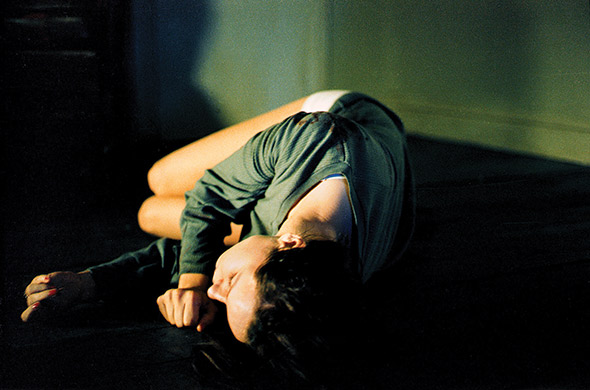
Text by Mitchell Miller
Photograph by Gautier Deblonde
My friend Elke is giving me one of her quizzical looks. It is a magical thing, encompassing amusement, pity and a quick scan of all available exits. A fellow film critic, she is compelled to unleash this interpersonal nuke as countermeasure to yet another intemperate rant over the state of Scottish cinema. As a German living in Glasgow, she is of course acclimated to my ranting (it’s our national sport) but as she patiently points out, my pessimism seems just a bit weird in light of the facts. Is it not the case that our actors are never off-screen? (Has someone cloned Brian Cox? Does he even have time to pee?) Do we not have a sudden glut of European co-productions? Doesn’t Scotland boast a clutch of very promising young directors – not to mention Shrek, the world’s only Scottish-accented ogre?
Sure enough, sharing my doubts over the rim of a half-empty glass of whisky does seem to be merely a stubborn force of habit belied by the evidence. In 2006, a number of Scottish (or at least, Scottish-accented) films have just gone into production; The Cone Gatherer with Dougray Scott, for instance, and the Gaelic-language, mythology-based feature Seachd (pronounced “shahkt”) as well as the biopic Nico by David Mackenzie (Young Adam, Asylum). What more could a quasi-independent nation of five million want? But then, being Scottish involves, on the one hand, punching above your weight, and on the other, revelling in heartburning Presbyterian gloom – sitting where extremes meet, to paraphrase the poet Hugh MacDiarmid. I generalize, but too much optimism sits ill at ease in a country of Celts and Calvinists.
But I’m not a pessimist – more a serial skeptic, and I’d say not without reason. For a start, Scotland has a tendency to strangle its best at birth, often through a misguided sense of what “punching above our weight” means. In the ’70s the Films of Scotland Committee (for years the only public body giving money to Scottish projects outside of London) turned down Bill Douglas, the greatest filmmaker this country has ever produced, not on grounds of artistic quality but because his proposed film “did not project Scotland as a forward-looking nation.”
Their decision only proved that where cinema was concerned, Scotland wasn’t. Douglas’ resulting trilogy (My Childhood, My Ain Folk, My Way Home) was an internationally recognized masterpiece, but the lack of regard in his homeland blighted his career and he only made one other film before his untimely death in 1991. Also strangled in the crib were Enrico Cocozza, the ’50s-era Italian-Scottish filmmaker, and Margaret Tait who now posthumously enjoys a growing reputation on the international art-film circuit. The comedic gifts of Bill Forsyth (Gregory’s Girl, Local Hero) were also never fully appreciated. Even the mighty John Grierson gave up his efforts to create an independent Scottish industry in disgust somewhere around 1960.
Given our great achievements in literature and music, we are conspicuously timid when it comes to embracing the living, breathing possibilities of the big screen. Critic and filmmaker Mark Cousins recently noted the complacency among our filmmakers who seem too happy to just get the work – any work. He finds that very few even think about form or debate “the shape and mode in which we tell our stories.”
I’d go further. Current Scottish cinema is characterized by a surfeit of activity and a serious deficit in purpose. It can be redressed, though; we do have some fine directors working today including Mackenzie, Lynne Ramsay (Ratcatcher), Peter Mullan (Orphans, Magdalene Sisters) and Kevin MacDonald (Touching the Void) – but we are still waiting for one of them to produce something truly authentic and memorable (and hopefully raise the bar for everyone else in the process).
The potential is there. The will to engage with the complex and contradictory beasts that are Scotland, the world and the human race in general also seem present and correct. So we wait, and hope it’s not for Godot (or Godard?). We rest our hopes perhaps too heavily on a small group of established professionals and the enduring heroin-chic of Trainspotting. We’re still not sure as to exactly what we’re waiting for – a film industry of our own? How could a nation of five million Scottish-speaking ogres possibly sustain that?
It’s true that quite a few European co-productions have emerged in recent years, offering an alternative to begging money from London. The Cone Gatherers will be a joint Irish-Scottish venture while Ken Loach continues his fruitful Anglo-Scottish partnership with Paul Laverty that produced My Name is Joe and Sweet Sixteen. Then there are the many prestigious Danish co-productions, including Lars von Trier’s Breaking the Waves and Lone Scherfig’s Wilbur Wants to Kill Himself. Such films are interesting cultural hybrids, but may represent a false hope based on a limited period of “inward cultural investment.”
In the long term we need to overcome our deep-seated Presbyterian mistrust of images. It does not help that many of our best writers have seen it as their job to counteract the “dishonesty” of cinema. Exhibit A was – and always has been – Brig-adoon, which has probably done more than any other movie to dampen Scots’s enthusiasm for seeing themselves reflected onscreen. But things have come a long way since Gene Kelly danced among phoney Scotch mist.
So maybe it’s time to cut back on the ranting and try a bit more encouragement. We do have a better setup, some promising people and – with digital – more options for the square pegs than in the days when Bill Douglas could be so badly treated. Maybe this and other armchair rants might goad some Scottish filmmaker into teaching the rest of us to keep our mouths shut – at least I’m certain that one long-suffering Teuton would be grateful.

